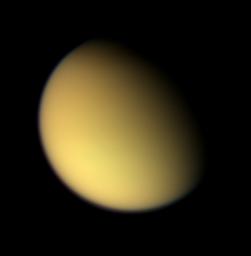Titan’s atmosphere may be telling us something about conditions on the early Earth. It’s thick and filled with interesting things like organic aerosol particles that form through the reaction of sunlight with methane gas. Translate that into terrestrial terms and you get a similarly hazy early Earth whose surface receives more than 100 million tons of organic materials every year. “As these particles settled out of the skies, they would have provided a global source of food for living organisms,” said Melissa Trainer (University of Colorado – Boulder).

Trainer is principal author of a new paper that examines the chemical qualities of these aerosol particles in the laboratory, studying their chemical composition, size and shape. The method: expose a mixture of methane and nitrogen to ultraviolet light, then add carbon dioxide to see if organic haze forms. And indeed, the haze forms readily in a wide range of methane and carbon dioxide concentrations. That smoggy sky over Titan may be similar to the haze that hung over the Earth for millions of years as the conditions for life emerged.
Image: As Cassini approached Titan on Aug. 21, 2005, it captured this natural color view of the moon’s orange, global smog. Images taken with the wide-angle camera using red, green and blue spectral filters were combined to create this color view. Credit: NASA/JPL/Space Science Institute.
Another benefit of the haze layer would be protection, shielding primitive organisms from ultraviolet light from the Sun and helping to stabilize the early climate. “It’s somewhat similar to the smog in Los Angeles,” adds Trainer. “Today’s haze on Earth is also created photochemically, which means sunlight powers chemical reactions in the atmosphere. However, the early atmosphere of Earth had different gases present, so chemical composition of the early haze is very different than the haze we have today. There also would have been a lot more of it.”
The paper is Trainer et al., “Organic Haze on Titan and the Early Earth,” accepted for publication in Proceedings of the National Academy of Sciences. The study was performed for NASA’s Astrobiology Institute.


Hi All
Early Earth would’ve been an alien place, shrouded in photochemical haze, with a weird mix of H2, N2, CO2, CH4 for air and probably oceans close to boiling point. If some ETIs had spied it from another system I’d say they’d be a tad dissappointed – another ‘lifeless’ planet. Recent work suggests the CO2/CH4 greenhouse lasted until the end of the Archean about 2.7 billion years ago, with the high temperatures being the main impediment to complex life evolving.
Imagine the transition that followed once cyanobacteria learnt the trick of oxic photosynthesis and enough leaked out of the oceans to start oxidising the methane. Things chilled sufficiently to cause the Great Huronian glaciation at c. 2.3 billion years ago. Then the greenhouse reasserted itself, but not like before, with the Earth merely sweltering rather than boiling until the terminal Proterozoic glaciations, Snowball Earth, followed in the wake of a spike in oxygen levels c. 0.8 billion years ago.
But even after a new equilibrium in the Cambrian oxygen and carbon dioxide have oscillated and not always in synchrony. Consensus has almost been reached that O2 rose from 6% in the PreCambrian to 35% in the Carboniferous, fell to just 10% after the Permian and stayed low well into the Cretaceous, eventually crawling back up to about 23% in the Paleogene.
So even when massive life existed on land the Earth hasn’t always been a ‘hospitable’ planet even if it was habitable. For example, the oxygen partial pressure in the Triassic can be calculated at about 0.088 bar (10% of the atmosphere, if N2 remained constant) which is getting pretty low, the equivalent of being most of the way up Everest.
Out in the Galaxy even more suprises await us I am sure.
Adam